View this page as a PDF (with references)
America’s Red Rock Wilderness Act: A Key Component to Achieving 30×30 and Mitigating the Climate Crisis
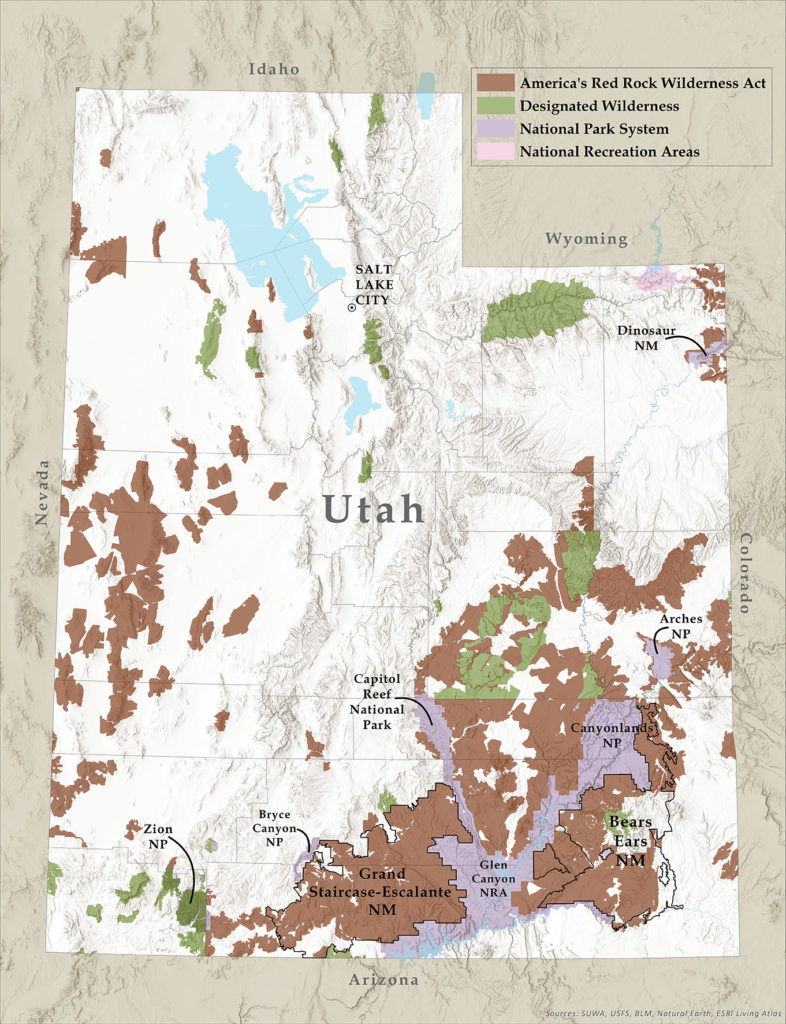 Spanning craggy mountain peaks in the Basin and Range province, the high plateaus and deeply incised mesas of Utah’s central uplands, and the world-famous redrock canyon country of the Colorado Plateau, the lands proposed for wilderness designation in America’s Red Rock Wilderness Act have long been recognized as some of the most extraordinary wild landscapes on the planet. There are many reasons to protect these lands: their stunning beauty, astonishing abundance of archaeological and Native American ancestral sites, world-class recreational opportunities, and important ecological values. Now, research shows that passing America’s Red Rock Wilderness Act–which would protect ~9 million acres of Utah’s public lands as federally-designated wilderness–would make a significant contribution to addressing two interconnected crises of our time:
Spanning craggy mountain peaks in the Basin and Range province, the high plateaus and deeply incised mesas of Utah’s central uplands, and the world-famous redrock canyon country of the Colorado Plateau, the lands proposed for wilderness designation in America’s Red Rock Wilderness Act have long been recognized as some of the most extraordinary wild landscapes on the planet. There are many reasons to protect these lands: their stunning beauty, astonishing abundance of archaeological and Native American ancestral sites, world-class recreational opportunities, and important ecological values. Now, research shows that passing America’s Red Rock Wilderness Act–which would protect ~9 million acres of Utah’s public lands as federally-designated wilderness–would make a significant contribution to addressing two interconnected crises of our time:
>> Extinction/Loss of Biodiversity
The continental United States loses a football field’s worth of natural areas every 30 seconds due to human activity. This loss of nature—accelerated by climate change—is a threat to the nation’s health and prosperity, affecting communities’ clean air, water, and defenses against severe weather, floods and wildfires.
–Senator Tom Udall
America’s Red Rock Wilderness Act: Moving America Closer to 30×30
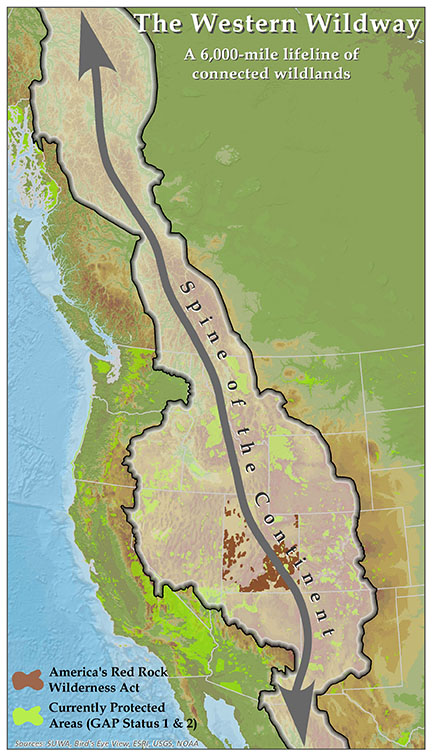 The Western Wildway, or Spine of the Continent, is a 6,000-milelong network of protected and unprotected landscapes stretching from northern Mexico to the Canadian and Alaskan Arctic. Preservation of such connected landscapes is essential to the conservation of wildlife species and biodiversity in the West.
The Western Wildway, or Spine of the Continent, is a 6,000-milelong network of protected and unprotected landscapes stretching from northern Mexico to the Canadian and Alaskan Arctic. Preservation of such connected landscapes is essential to the conservation of wildlife species and biodiversity in the West.
To stop the loss of nature and address the climate crisis, scientists say we need to protect 30% of the earth’s lands and waters by 2030, with the ultimate goal of keeping 50% natural.
In the United States, only 12% of land is currently protected. Most of these lands exist in isolated fragments, surrounded by human development.
To maintain healthy functioning ecosystems, preserve biodiversity, and mitigate impacts from climate change, we need to protect more land—and the benefits increase dramatically when we protect large landscapes that connect ecosystems and wildlife habitat. America’s Red Rock Wilderness Act will protect ~9 million acres of unspoiled public land in its natural state—one of the largest remaining expanses of unprotected wild country in the continental U.S. Equally important, passage of America’s Red Rock Wilderness Act will increase landscape connectivity in the region, providing a critical link in the chain of predominantly natural landscapes known as the Western Wildway.
Such connectivity is critical to mitigating the climate and extinction/biodiversity crises.
America’s Red Rock Wilderness Act accounts for 1.5% of the remaining land that needs to be conserved to reach the goal of protecting 30% of land in the United States by 2030.
30×30 Campaign to Save Nature
The 30×30 Campaign to Save Nature is a global initiative that calls for the preservation of 30% of the earth’s lands and oceans by 2030, with the ultimate goal of preserving 50% by 2050—objectives deemed necessary to stem the loss of nature, prevent mass extinction of species, and mitigate the impacts of climate change.
Leading scientists, conservationists, and a growing number of political leaders support the
initiative, as do 86% of Americans. Read more about 30×30 here.
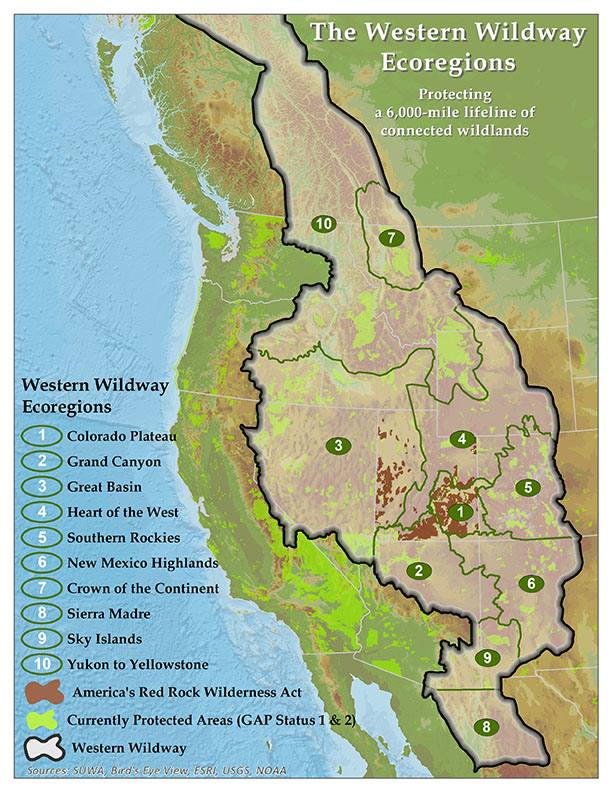 Why Landscape Connectivity Matters
Why Landscape Connectivity Matters
Connectivity is “the degree to which the landscape facilitates or impedes movement.” Movement is important because existing protected areas are simply not large enough to conserve the diversity of species, habitats, and processes necessary to sustain healthy plant, animal, and even human life on our planet. As natural areas are increasingly lost, degraded, and fragmented, species become isolated in patches of habitat, surrounded by a human dominated landscape. The result is a decline in the distribution and numbers of many wildlife and plant populations in the United States.
Climate change makes this situation worse. Fragmented landscapes are less resilient to the changing conditions, ecological disturbances, and new forms of disease that accompany climate change.
Increasing landscape connectivity can help. Increased connectivity facilitates species movement, which enhances gene flow, reduces the risk of extirpation in isolated populations, and allows suitable habitat patches to act as stepping stones as species shift their ranges in response to changing climate conditions.
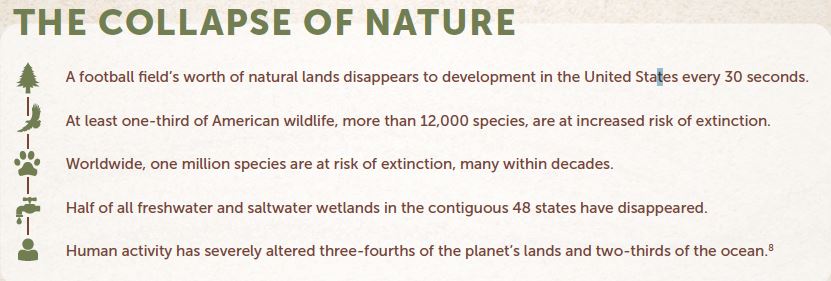
This is the healthiest, most intact country in the West. The Central Colorado Plateau is, by and large, a connected set of roadless areas that completes a landscape linkage to wildlands networks to the north, south and east.
–Senator Tom Udall
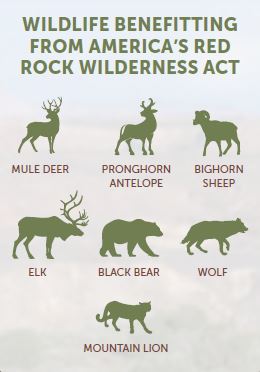 America’s Red Rock Wilderness Act: Lifelines for Wildlife
America’s Red Rock Wilderness Act: Lifelines for Wildlife
Passage of America’s Red Rock Wilderness Act would conserve five key wildlife corridors that are essential to biodiversity, not only in Utah but in ecosystems all along the continental Western Wildway. These wildlife corridors are part of three major wildlife megalinkages that facilitate wildlife movement from Mexico to the Canadian and Alaskan Arctic.10
Because many lands in America’s Red Rock Wilderness Act are targeted for energy development, action is essential to conserve these critical wildlife corridors.
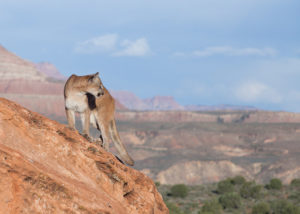 Wildlife corridors increase movement between habitat patches by approximately 50%, compared to patches that are not connected by corridors. Linking protected areas, such as national parks and wilderness areas . . . ensures larger, cohesive landscapes of high biological integrity that allow for the migration, movement, and dispersal of wildlife and plants.
Wildlife corridors increase movement between habitat patches by approximately 50%, compared to patches that are not connected by corridors. Linking protected areas, such as national parks and wilderness areas . . . ensures larger, cohesive landscapes of high biological integrity that allow for the migration, movement, and dispersal of wildlife and plants.
–Center for Large Landscape Conservation
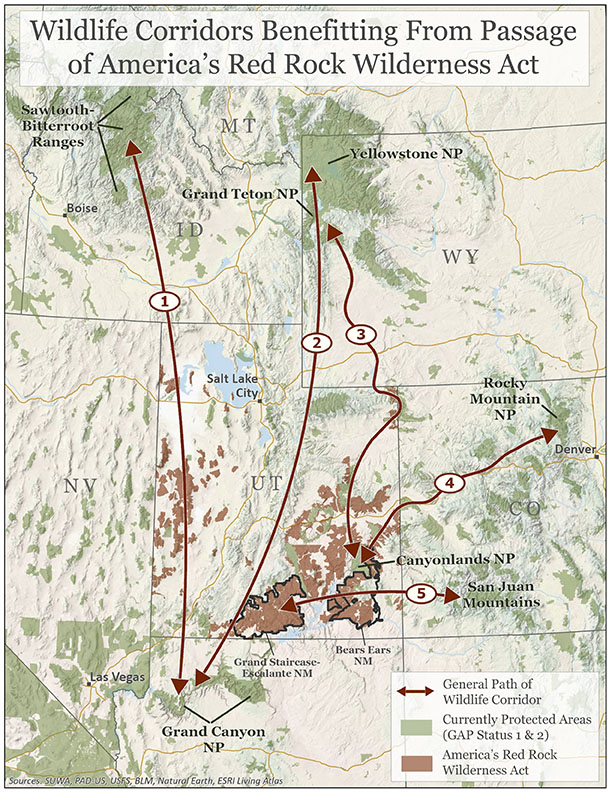
1. Grand Canyon to
Bitterroot Wilderness
Connects Grand Canyon to Idaho’s Sawtooth and Bitterroot Ranges
2. Grand Staircase
Connects Grand Canyon to Yellowstone National Park
3. Green River
Connects Greater Canyonlands to Grand Teton National Park
4. Upper Colorado River
Connects Greater Canyonlands to Colorado’s Rocky Mountains
5. Grand Staircase to
San Juan Mountains
Connects Grand Staircase and Bears Ears to Colorado’s San Juan Mountains
America’s Red Rock Wilderness Act: Mitigating the Climate Crisis
In order to address the climate crisis, it is necessary to drastically reduce greenhouse gas emissions from the production of fossil fuels while simultaneously increasing carbon sequestration and storage. A 2020 analysis by EcoAdapt, “Contribution of America’s Red Rock Wilderness Act to Climate Change Adaptation and Mitigation Efforts,” 12 shows that passage of America’s Red Rock Wilderness Act can make a significant contribution on both fronts.
Reducing Greenhouse Gas Emissions
In order to avoid severe and irreversible impacts from climate change, scientists have identified the amount of carbon that can be released into the atmosphere before global temperatures rise more than 1.5 to 2 degrees Celsius above pre-industrial levels, as called for by the Paris Agreement. This is known a the “carbon budget.” The goal is to live within that budget. Keeping fossil fuels in the ground under America’s Red Rock Wilderness Act would contribute significantly to achieving this goal.
The 2020 analysis by EcoAdapt shows that by preventing the development of unleased fossil fuels, passage of America’s Red Rock Wilderness Act would:
• Permanently keep in the ground greenhouse gasses equivalent to 5.7% of the carbon budget necessary to limit warming to 1.5 degrees Celsius. This amount is comparable to 3.6 years of U.S. greenhouse gas emissions at 2018 levels.
• Permanently keep in the ground greenhouse gases equivalent to 2.1% of the carbon budget necessary to limit warming to 2 degrees. This calculation is based on unleased fossil fuels that lie under lands in America’s Red Rock Wilderness Act, including coal, oil and natural gas, oil shale, coalbed methane, and tar sands.
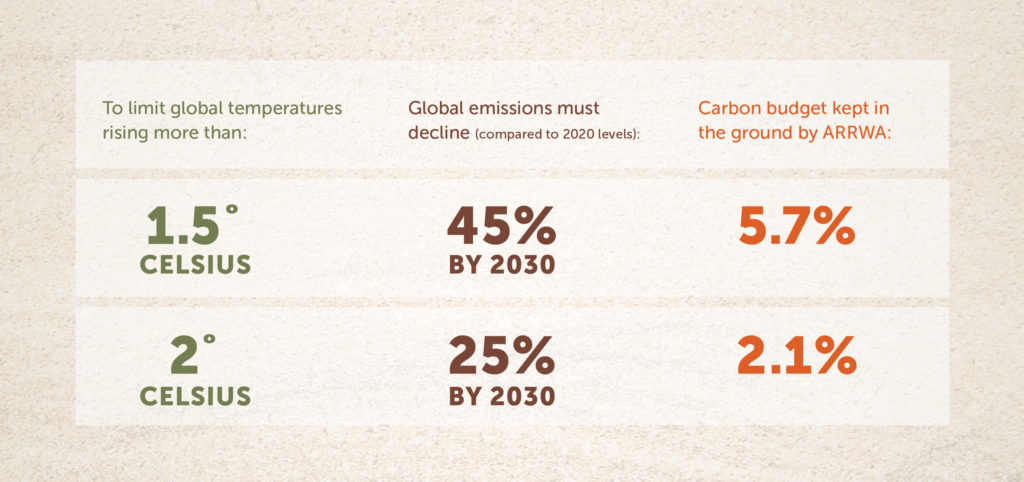
Removing Carbon From The Atmosphere: Sequestration and Storage
Maximizing carbon sequestration and storage by plants and soils is a critical component of climate mitigation. Sequestration removes carbon from the atmosphere that would otherwise contribute to climate change.
Although tropical and temperate rainforests are widely recognized as major sources of sequestration, dryland ecosystems also make a significant contribution. Woody vegetation, shrublands, and desert biocrusts all play a role in sequestering carbon—which is why protecting desert wilderness should be an important piece of the nation’s climate policy.
Scientists have estimated that the lands contained in America’s Red Rock Wilderness Act currently sequester and store 247 million metric tons of organic carbon in plants and soils. Permanently protecting these lands as wilderness not only keeps this stored carbon out of the atmosphere—it pays climate dividends because plant biomass continuously pulls carbon out of the atmosphere. Thus, preventing the loss or degradation of plant biomass by protecting lands in America’s Red Rock Wilderness Act will allow continued sequestration and storage of carbon, which is expected to increase to an estimated 271 million metric tons by the end of the century. This is an increase of nearly 10% over the amount of organic carbon currently stored on lands in America’s Red Rock Wilderness Act.
The total amount of carbon stored in the landscape may be significantly higher than the above estimate. Scientists have been learning more about the role of caliche in long-term storage of inorganic carbon beneath the landscape. Below desert biocrusts, caliche is formed from reactions between fungi and the respiration of carbon dioxide from plant roots and microbes, which create crystals of calcium carbonate underground. The amount of carbon stored in this inorganic state may be double or triple the amount of stored carbon described above. If soils are disturbed, these benefits are lost. America’s Red Rock Wilderness Act would protect millions of acres from industrial disturbance.
If soils are disturbed, these benefits are lost. America’s Red Rock Wilderness Act would protect millions of acres from industrial disturbance.
The Role of Biocrusts in Climate Mitigation
Biocrusts are living organisms—composed of cyanobacteria, algae, lichens, and mosses—that form a protective mat or seal across much of the land in America’s Red Rock Wilderness Act. They play a critical role in mitigating climate change impacts, but only if they are not disturbed.
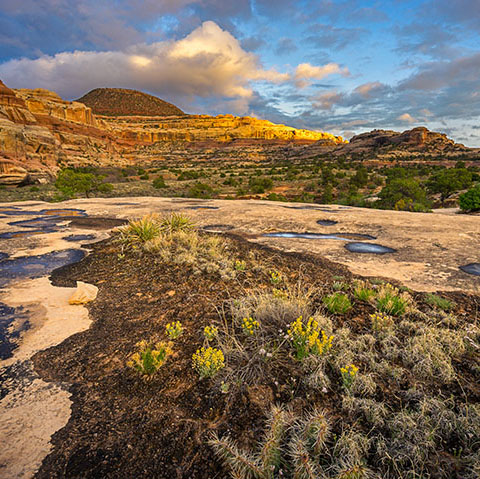
Biocrusts take decades to mature but are swiftly destroyed by surface disturbing activities like vegetation removal projects, mining, oil and gas drilling, off-road vehicles, and grazing.
BIOCRUSTS:
• Hold soil together, dramatically decreasing windblown dust
• Sustain Colorado River flows by reducing “red dust on white snow”
• Sequester carbon through photosynthesis
• Facilitate the formation of caliche, a significant means of carbon storage
• Increase soil moisture, helping to sustain vital water supplies
• Reduce invasion of exotic plants, preserving biodiversity
America’s Red Rock Wilderness Act: Helping Ecosystems Adapt to Climate Change
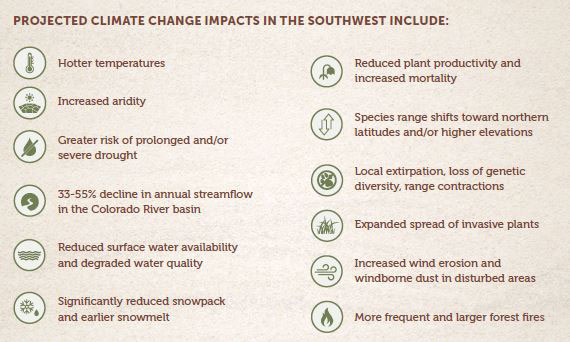 Climate change is predicted to wreak havoc in the desert southwest over the coming century, disrupting and degrading the well-being of wildlife, plants, and humans.
Climate change is predicted to wreak havoc in the desert southwest over the coming century, disrupting and degrading the well-being of wildlife, plants, and humans.
Protecting lands in America’s Red Rock Wilderness Act will help ecosystems adapt by increasing landscape connectivity, protecting climate change refugia, and reducing surface disturbances that exacerbate the impacts of climate change.
Protecting Climate Change Refugia
Climate change refugia are locations where plants and animals can potentially weather the changes that climate change brings.
Because these areas are buffered from exposure to rapid changes and climate extremes, they buy time for range shifts and/or genetic adaptation over longer time scales. They can also protect populations from extirpation following extreme events (e.g., severe drought or wildfires), serving as sources for recolonization of the surrounding landscapes. This is important because climate change is predicted to disrupt and degrade existing habitats, reducing biodiversity and contributing to the risk of species extinction.
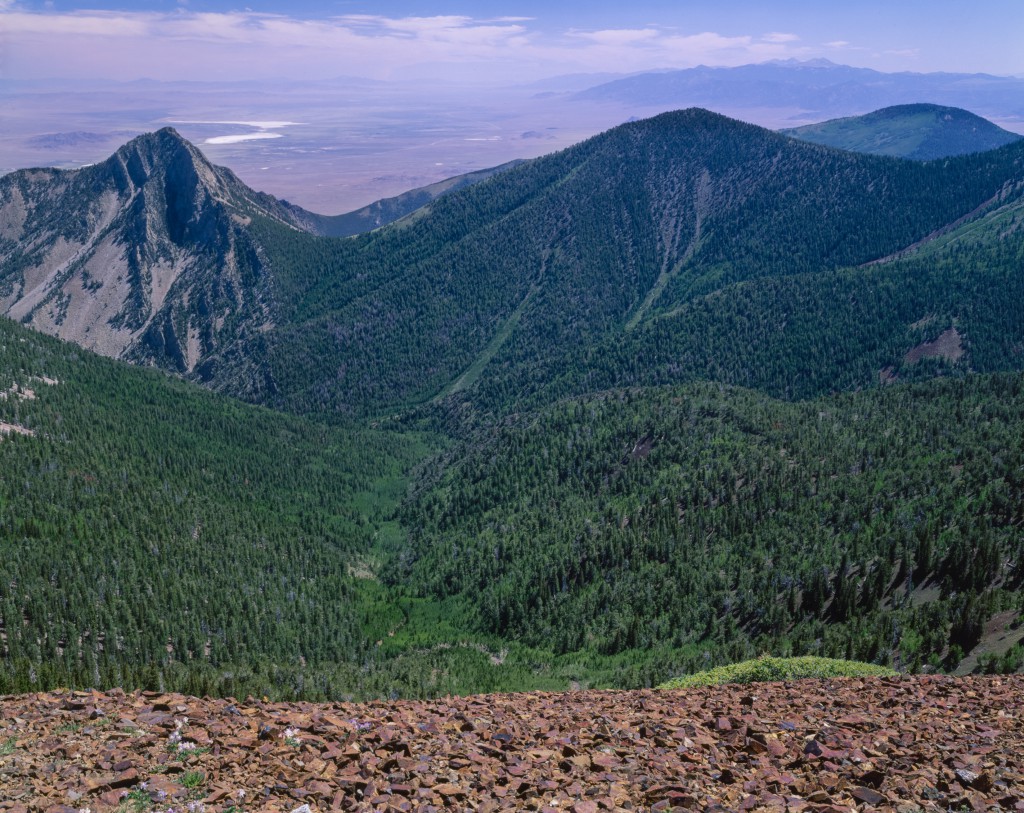
Lands that would be protected under America’s Red Rock Wilderness Act are associated with conditions that tend to create a high proportion of climate change refugia–namely, very high topographic and geophysical diversity, and lower climate change velocity. This means that they play a significant role in helping plants and animals adapt to climate change.
Action is essential, however, estimates say that 70-80% of refugia in the Central Basin and Range and Colorado Plateau ecoregions remain unprotected.
Wilderness designation of ARRWA lands would result in the permanent protection of areas likely to serve as important climate change refugia (i.e., areas that are buffered from exposure to rapid changes and climate extremes), which are largely unprotected at low elevations within this region.
–EcoAdapt: Contribution of the America’s Red Rock Wilderness Act to Climate Change Adaptation and Mitigation Efforts
- America’s Red Rock Wilderness Act: Protecting Colorado River Flows
Windblown desert soils landing on mountain snowpack in Colorado are significantly reducing the annual flow volume of the Colorado River. When the soils land on snow, they cause the snow to melt faster and sooner than it normally would. This early runoff has reduced annual flows by more than 5%. Various studies predict that climate change will further reduce runoff into the Colorado River by 7-20%.
This has alarming consequences. More than 40 million people depend on the Colorado River, and farmland irrigated by the river produces some 15% of the nation’s crops. The river is also the lifeblood of diverse ecosystems along its path.
Normally, desert soils are held in place by biological soil crusts which form a mat-like matrix highly resistant to erosion by wind and water. However, biocrusts are extremely fragile, and therefore highly susceptible to damage from human-caused disturbance. Once disturbed, they take decades or even centuries to recover.
Protecting lands in America’s Red Rock Wilderness Act can help. Wilderness designation will prevent many surface disturbing activities that destroy biocrusts, reducing windblown dust and its effect on Colorado River flows.
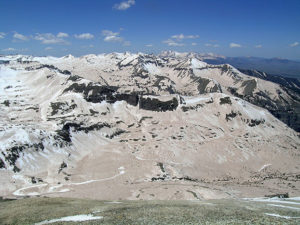 Red Dust on White Snow
Red Dust on White Snow
Here’s how it works: Wind storms pick up desert soils from the Colorado Plateau that have been disturbed by activities such as vegetation removal, off-road vehicle use, and grazing. Those wind storms then deposit that dust on mountain snowpack throughout the Rockies.
Photo: Red dust on Colorado’s San Juan Mountains. Center for Snow and Avalanche Studies.

